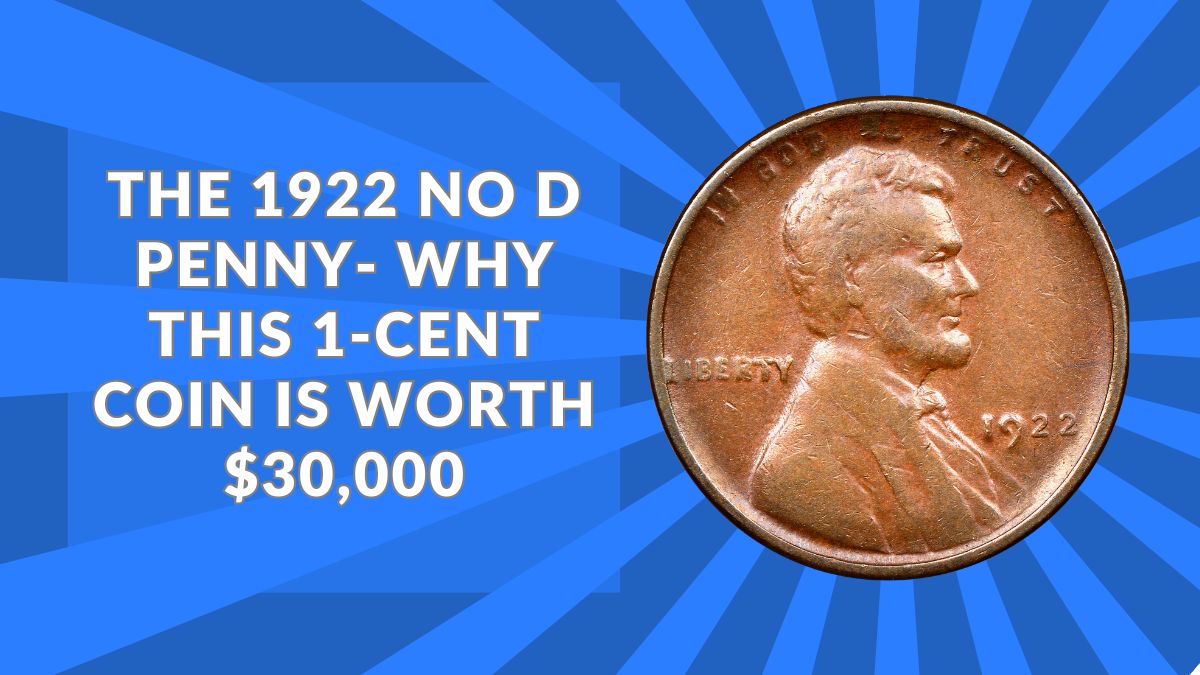The world of coin collecting is filled with intriguing anomalies, but few are as captivating as the 1922 No D Lincoln Wheat Penny.
This rare variant of the Lincoln cent has captured the fascination of numismatists and collectors alike, often commanding prices upwards of $30,000 at auctions.
Let’s delve into the origins, distinguishing features, and valuation of this remarkable coin.
The Genesis of the 1922 No D Penny
In 1922, the Denver Mint was the sole producer of Lincoln cents. All pennies from that year were intended to bear the “D” mint mark, signifying their Denver origin. However, an unusual occurrence led to the creation of the No D variety.
Overworked and deteriorating dies were excessively polished by mint workers in an attempt to extend their usability. This over-polishing inadvertently removed the “D” mint mark from some coins, resulting in the elusive 1922 No D Penny.
Identifying the 1922 No D Penny
Not all 1922 pennies without a visible “D” mint mark are genuine No D varieties. To accurately identify this rare coin, collectors should observe the following characteristics:
- Strong Reverse Details: The most sought-after No D pennies exhibit a sharp and well-defined reverse design, indicating they were struck with a fresh reverse die.
- Die Pair Classifications: There are four recognized die pairs associated with the 1922 No D and Weak D varieties. Die Pair #2 is particularly notable for consistently producing coins without the “D” mint mark and featuring a strong reverse.
Valuation and Market Trends
The value of a 1922 No D Penny is influenced by several factors, including its condition, coloration, and the specific die pair from which it originated. Here’s a breakdown of recent market valuations:
| Grade | Description | Approximate Value |
|---|---|---|
| Good (G-4) | Heavily worn but date and major details visible. | $125 |
| Extremely Fine (EF) | Light wear with all design elements sharp and clear. | $650 |
| Mint State (MS-63) | Uncirculated with minor imperfections; strong reverse. | $3,600 |
| MS-64 Red & Brown | Slightly higher quality with more red hues. | $4,600 |
| MS-64 Red | Predominantly red coloration; highly sought after. | Up to $50,000 |
It’s noteworthy that fully red specimens with a strong reverse are exceedingly rare and can command premium prices, sometimes reaching $50,000 or more.
Factors Influencing Value
Several elements contribute to the valuation of the 1922 No D Penny:
- Condition: Coins in better condition, especially those in uncirculated grades, are more valuable.
- Coloration: Coins are graded based on their color—Brown (BN), Red-Brown (RB), and Red (RD). Red coins, indicating minimal oxidation, are the most desirable.
- Die Pair: Coins from Die Pair #2 with a strong reverse are particularly prized among collectors.
Collecting and Authenticating the 1922 No D Penny
Given the coin’s rarity and value, authentication is crucial. Collectors should consider the following steps:
- Professional Grading: Submit the coin to reputable grading services such as Professional Coin Grading Service (PCGS) or Numismatic Guaranty Corporation (NGC) for authentication and grading.
- Die Analysis: Familiarize yourself with the die pair characteristics to ensure the coin matches the known attributes of genuine No D pennies.
- Market Research: Stay informed about current market trends and recent auction results to understand the coin’s value.
The 1922 No D Lincoln Wheat Penny stands as a testament to the fascinating intricacies of coin minting and the allure of numismatic anomalies. Its accidental creation, combined with its rarity and the stories it carries, makes it a coveted piece for collectors.
Whether you’re a seasoned numismatist or a curious enthusiast, the pursuit of this one-cent wonder offers a glimpse into the rich tapestry of minting history and the enduring value of meticulous craftsmanship.
FAQs
How can I distinguish a genuine 1922 No D Penny from a regular 1922-D Penny with a weak mint mark?
Genuine 1922 No D Pennies typically exhibit a strong reverse design and lack any trace of the “D” mint mark. Coins with a weak or faint “D” are considered separate varieties and are generally less valuable.
Why were no pennies minted at the Philadelphia Mint in 1922?
In 1922, the Denver Mint was solely responsible for producing Lincoln cents, leading to the absence of Philadelphia-minted pennies that year.
Is it worth investing in a 1922 No D Penny?
As with any investment, it’s essential to conduct thorough research and consult with numismatic experts. The 1922 No D Penny has historically appreciated in value, but market conditions can fluctuate.

I have a 1922 no D ( I believe ) and there is a die chip on the 2nd 2 which made it look like a 1921 P when I bought a random blue book penny collector. All the key markers for the 22 no D weak reverse are present but not sure what to do with it